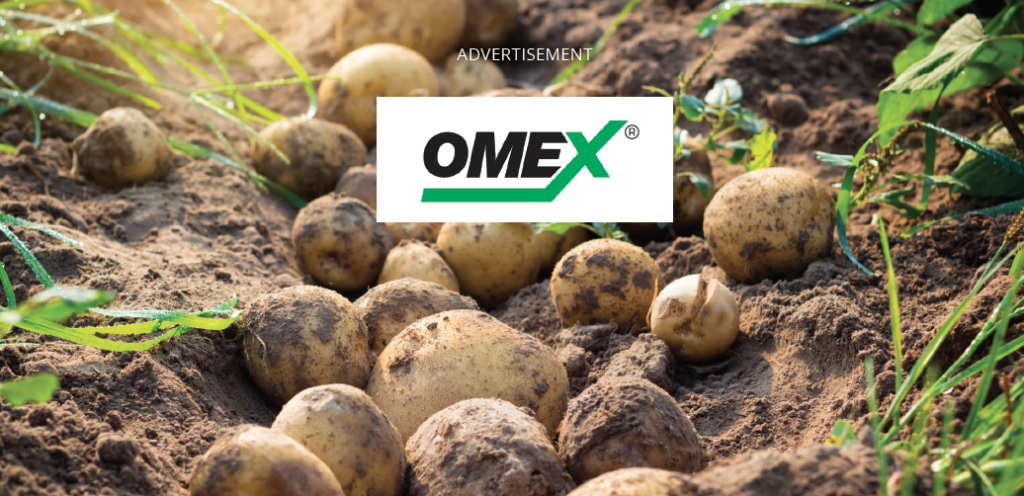Organic acids: a known unknown

(Sponsored) Whatever you’re planting this year, spare a thought for your soils. We expect a lot of them, but modern agricultural practices take a lot in turn, often leaving them unable to fully support the demands of the crop, says Dean Konieczka, consultant agronomist with OMEX® Agrifluids.
What’s the best soil in which to grow potatoes? Yep, it’s those light sandy soils that ease planting and cultivations, while keeping buyers happy with clean produce and low soil tares. And what do we do to these lovely light soils? We fumigate them, we fertilize them, we work them hard. Yet still we expect them to deliver strong, high-yielding healthy crops.
Truth is, we need to look more closely at our soils. Of all crops, potatoes are especially reliant on good quality soil. But like a rock star at a concert, these perfect soils expect careful management if they’re to perform to their full potential.
All this cultivation and chemical activity — fall fumigation, stone removal, tilth creation, bed-forming and so on — leaves the soil in a state that doesn’t adequately support uniform plant growth and, latterly, tuber development.
Organic matter, what we call ‘sustainable carbon’, can be lost from the soil under these intense conditions. Without a minimum level of organic matter, microbe activity becomes depressed, leading to inadequate colonization within the crop’s root zone.
In turn, this creates an environment where applied fertilizers become largely ineffective: despite their ‘artificial’ nature, plants rely on microbial activity to effect adequate nutrient absorption, uptake and utilization.
It’s often said we don’t fully understand the soil on which we stand and it’s easy to see why. Just a single teaspoon of ‘average’ soil contains up to one billion bacteria, yards of fungal filaments, thousands of protozoa and scores of nematodes — each of which plays a role in the soil merry-go-round.
While some of those players aren’t welcome — certain nematodes, for example — plenty more are essential for healthy crops.
Bacteria such as Rhizobium display the unique ability to fixate nitrogen from the atmosphere. Various fungi — mycorrhizae — form a partnership with plant roots, boosting their ability to absorb soil nutrients. Both rhizobium and mycorrhizae produce substances such as polysaccharides and nutrient salt complexes that bind soil particles into larger aggregates, improving water retention and preventing soil erosion.
Protozoa, meanwhile, constitute an important link within the soil food chain, consuming bacteria and producing as much as 80 percent of the soil nitrogen that eventually ends up in plants, while themselves being a food source for invertebrates.
Then there’s the earthworm: mixing up soil, deep-diving with surface organic matter that stimulates bacteria and increases water retention.
It’s easy to see how this complex web can be upset; even basic forms of agriculture can affect the balance and negatively impact soil health. Although we’ll never farm without affecting the soil jungle in some way, there are remedial steps that can ameliorate the situation.
Enter organic acids. These aren’t acids in the broader sense of the term — they won’t dissolve anything — but weak chemical acids, formed during breakdown of soil organic matter. Research shows their crucial roles in physiochemical processes such as mineralization and solubilization, while contributing to the carbon cycle, detoxification of metals and, importantly, the uptake of applied nitrogen and nutrient complexes such as DAP and MAP.
Organic acids come in various forms, comprising a variety of biological compounds produced through biotic and abiotic soil processes. ‘Humic acid’ is insoluble in water and is one of the key components instrumental in soil binding. ‘Fulvic acid’, on the other hand, is water-soluble, playing a vital role as a nutrient facilitator and also as a ‘chelator’ — binding nutrients such as phosphorus, calcium and iron — that would otherwise bind together and become inaccessible to the plant.
What both these compounds, alongside another called humin, have in common is that we still don’t fully understand them! Observations in soil research — such as those conducted by the universities of Ohio State and North Carolina — have shown how relatively small doses of humic acids increase plant growth and root mass, but the chemistry and function itself remains the subject of much debate.
It’s this lack of understanding, the inability to explain fully how these substances work, that has often left them on the periphery of crop nutrition. And because they’re naturally occurring substances, which can’t be protected by patents, there’s little incentive beyond the research community to conduct research that could be used commercially. Vitamin D in human health is a good parallel; we know it can help protect us against respiratory disease, but we don’t know why or how, and no drug company will fund such research without prospect of a return on investment.
Despite these issues, OMEX® has stuck — perhaps stubbornly — with organic acids. We recognize that when growers use products such as Cell Power® SLYCE and our other formulations, not only do they produce a result but an evidently valuable result, especially in soils low in organic matter. Typically, we see the effect of SLYCE in vigor: good shoot and root development. But it also promotes chlorophyll development and improves potassium transport, both of which increase the plant’s ability to cope with stress situations later in the season, such as hot weather and drought.
Developing the proper form, timing and rates to use organic acids through the growing cycle is crop and climate specific. You, or your agronomist, will need to consider factors such as nutrient use, water availability and soil type — and of course, OMEX® is always available to help you get the most from organic acids in your potato crop.
Learn more at www.omexusa.com.
The product names and brands referenced here are registered and trademarks of OMEX® Agrifluids, Inc.
© OMEX® Agrifluids, Inc. 2021.







